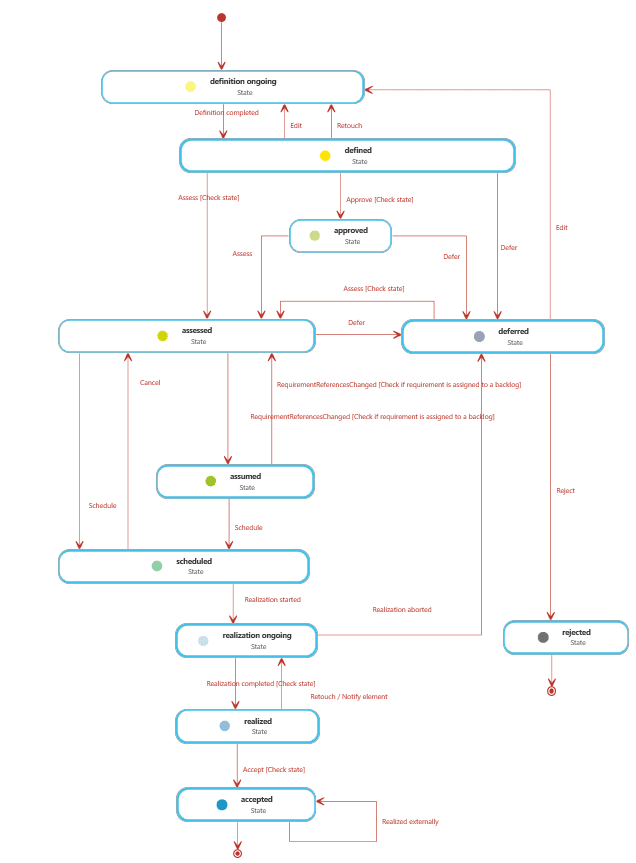When you first get to our website, you’ll discover several products with similar names. All of them have something to do with requirements. So what actually distinguishes them?
Today we’re clearing things up. A simple equation helps:
objectiF RM = Requirements Engineering Software
objectiF RPM = objectiF RM + Project Management Software
Another way to say the same thing: objectiF RPM contains objectiF RM. Both applications are the result of one product development line. In addition to products, objectiF RPM has activities you can use to plan and control projects. For those who don’t just want to work statically with requirements, but also want to tackle their implementation, objectiF RPM does both.
Better requirements
Many people are interested in our products because they want to better analyze, document and manage requirements. objectiF RM offers a variety of features for this. Requirements, stakeholders, goals, change requests, risks, test cases and more can be described, versioned and managed in lists. Graphical models (UML and SysML) offer support for communicating what may be hard to understand in natural language or for when the HOW of system behavior has been imprecisely described. The results of the requirements engineering process can be exported as an up-to-date document at any time. Agile developers also have the option to generate product backlogs or fine-grained release and team backlogs. objectiF RM helps requirements engineers with everything they need in order to hand over requirements to developers in the best way possible.
Iterative and incremental
It’s rare for requirements to be delivered and then satisfied in a completely linear process. Often changes arise that have effects on all the relationships identified during the requirements engineering process. That means that requirements need to be re-specified. Iterative and incremental is the motto of many agile methods. That means that requirements analysis needs to be looped into this process of short cycles. While it’s possible to trade information back and forth across various interfaces, it’s certainly easier to drag and drop requirements directly into backlogs and get project planning underway. objectiF RPM makes this possible. You can start with objectiF RM to ensure the quality of your requirements and then “upgrade” to objectiF RPM for support with the iterative development process. You can even do this while working on your current project, as both applications are 100% compatible.
Keeping the entire system in view
Systems approaches are in vogue. The so-called silo mentality has become an object of criticism. This critique applies to the product development life cycle as a whole. Each developer is supposed to be aware of the big picture, the goal that’s being worked towards. In order to adequately grasp causal relations and other connections, it’s necessary to represent them clearly and accessibly. Our software is designed for this. Supposing a developer needs to know why a stakeholder wanted a particular feature, she can trace backwards from a user story in a sprint backlog all the way back to the original requirement, including a complete change history. It’s even possible to trace a requirement to and from the code that implemented it. The more complex an application is, the more important the forwards and backwards traceability offered by objectiF RPM.
The status of requirements
If you want to optimally manage requirements over the entire life cycle, you’ll need to take their status into account during development and testing. This state machine diagram for requirements shows all possible states up to acceptance.

It’s also possible to customize state machines to match your own procedures. If your development process involves more or less steps, it’s easy to modify the state machine through the diagram interface in settings.
Bonus points in project management
For a seamless transition from requirements engineering to project management, objectiF RPM is the solution. Simply select items from the product backlog, refine them further for sprint backlogs and assign staff and resources. For visual task management, Kanban boards and user story boards can be used. For scheduling sprints, releases, and other activities, classical Gantt charts are an option. You can check the progress of activities and planned requirements at any time using earned value analyses, burn up and burn down charts, cumulative flow diagrams, and other individually customizable KPI dashboards. Network diagrams and critical path are also available. Deadlines, costs and resources can be calculated for activities and analyzed in special views with plan/actual comparisons. Several of these project management reports and tasks can even be automatically generated or run with a task manager. objectiF RPM’s state machines make this possible.
To find out more about what our applications can do and how their features differ, take a look in our whitepaper objectiF RM and objectiF RPM in Comparison.

